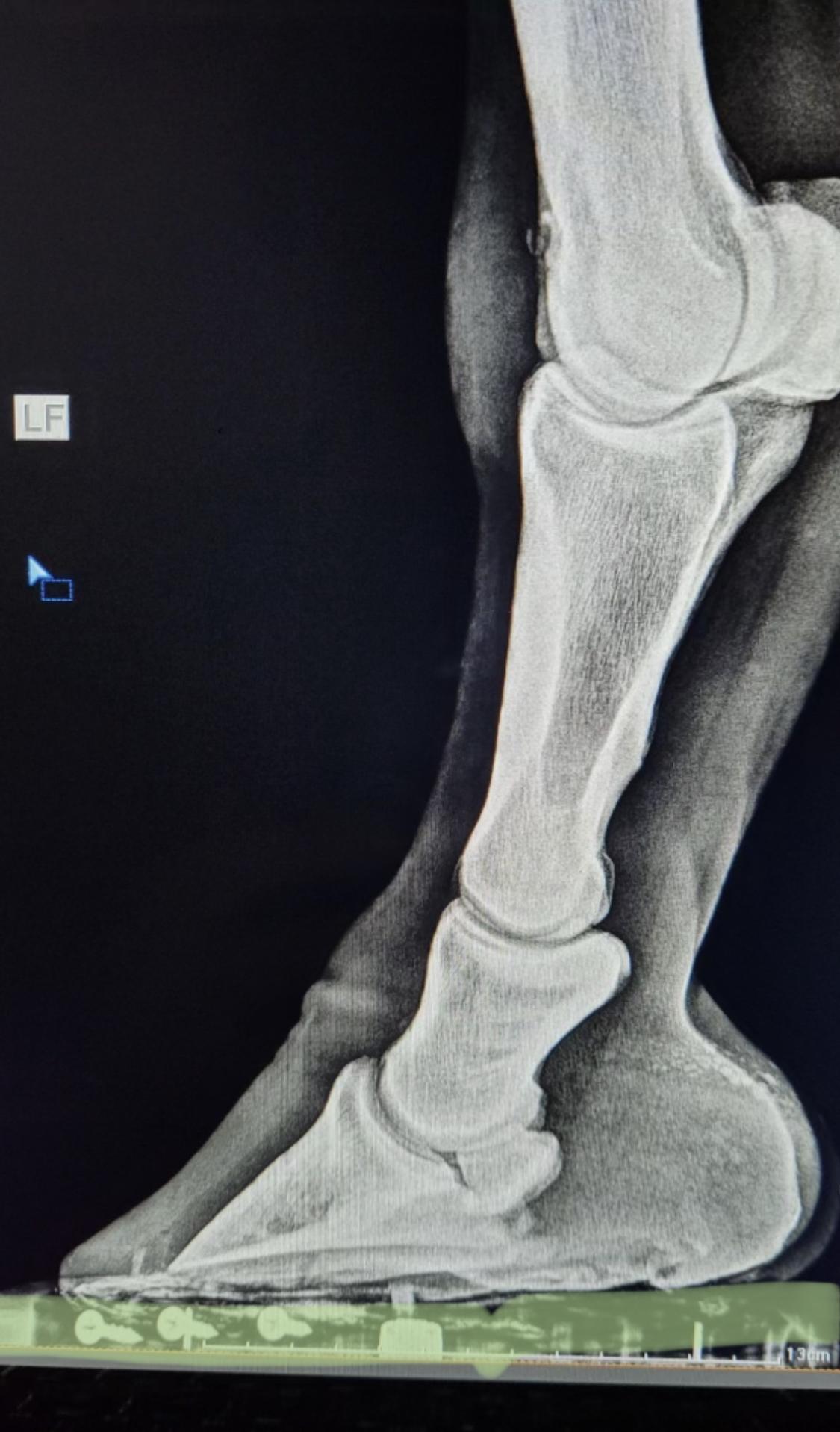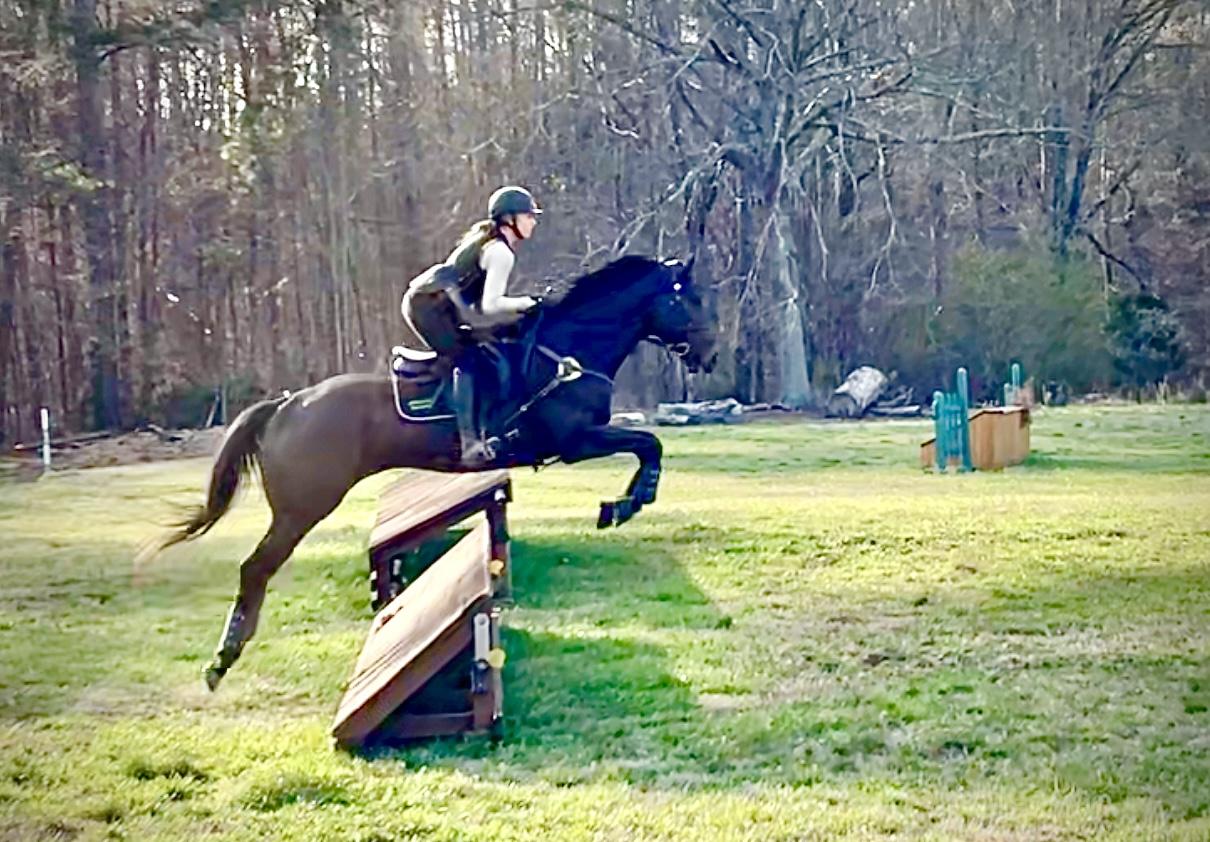
Thoroughbred Logic: When Feet Are Really Bad — Mountain’s Story
Last week’s Thoroughbred Logic centered on typical post-track Thoroughbred feet and their commonly long toes and low, under-run heels. This week’s article centers on a more extreme case: Mountain Holiday and his horrible hooves.
Welcome to the next installment of Thoroughbred Logic. In this weekly series, Anthropologist and trainer Aubrey Graham, of Kivu Sport Horses, will offer insight and training experience when it comes to working with Thoroughbreds (although much will apply to all breeds). Come along for the ride as she offers a case study of one particularly bad set of Thoroughbred feet.
Last week, I discussed typical post-track Thoroughbred feet and their commonly long toes and low, under-run heels. This week’s article centers on a more extreme case: Mountain Holiday and his horrible hooves.
Let’s start with where we are now.
Two weekends ago, Mountain packed around his first three-phase schooling show, leading the Tadpole division from start to finish. Better yet, he had only started over fences about two weeks before. I would have been pleased with any horse pulling this off. But it is Mountain – and his maybe-Cinderella story makes me (cautiously) very excited.
See, back in September, conversations about Mountain did not include show dates or cross-country schooling. They did not even include riding. Rather, they focused on the fate of his feet, and therefore, his fate writ large. Part of a critical conversation with my farrier (who is also a good friend and my go-to for business advice) went like this:
“What do we do?”
“Honestly, Aubrey…” he paused, squared up and said, “look, you run a business, this is far from good. He’s in pain. He’s going to cost you a fortune in time and money and we don’t know if we can fix him. I don’t like to say it, but you need to think about all of the options — and that includes euthanasia.”
“No.”
“I know. But you have to consider all the options.”
“Not that one. Not this horse. So… what do we do?”
*As an aside, sometimes euthanizing a horse is the kindest thing we can do for seriously painful problems (but that will be its own article later in the series).

Mountain hacking around at the farm before we knew how bad his feet truly were. Photo by Audrey Mecklenburg.
These were not just “kinda bad” Thoroughbred feet. They were disastrous. I had a vet grab radiographs the week before. What we found made her go, “Oh good lord.” You could literally use your thumbnail to scratch through his sole to his coffin bone.
The conversation about Mountain’s fate went in circles throughout the many hours of shoeing my barn that day. There were really two choices. I didn’t like either of them. Pull his shoes, turn him out and see if he got better or worse… (with an anticipated lot of pain to start and some grave consequences if he didn’t grow sole) or try a rarely-used tactic and literally screw him into plywood, cover his feet in casting tape and leave him in a stall for an undetermined amount of time. Either way, hope played a worryingly large role in both options.

Mountain’s left front standing on a radiograph plate. His coffin bone is just about sitting on the ground. Radiograph courtesy of Barrow Veterinary Services.
Thin soles are a pretty typical problem for Thoroughbreds. Not all of them have them, but when they go sore, it’s a common cause. Options that often help include good nutrition, proper supplements, shoes, topical hardening magic potions, and pads (leather, pour in, frog support, etc.) to protect the foot and to keep it from prolapsing. I also have friends that have had super success just kicking a horse out in the field for a year and letting them grow in between regular trimmings. But as with all things, none of these options are guaranteed to work (alone or in combination).
By the time we got the x-rays on Mountain’s feet, we had tried all of the above options for at least short periods of time. He needed a radical intervention. I turned him out for a few hours and let him run like a madman for potentially the last time for a long while. By the end of the day, he had checked in for his undetermined amount of stall rest. I’m not a particularly religious person, but if I was, there would have been a bunch of prayers sent up, all targeted at the bottom-most point of his body. Grow sole, Mountain.
I wanted (and still want) Mountain to be a Cinderella story. The lovely creature is kind, goofy, and willing. He will follow you around like a puppy, attempt any ask, and stand for hours and just hang out with you if its what you need that day. His brain is amazing — his body, not so much. At 17.1-hands at the hind-end and growing on patently bad feet, he needed all the hopes and prayers he could get.
He wouldn’t be the first horse I have hung such hopes on. I wanted Fletcher (JC Reflection) to be the same unexpected success story – with a knee full of osteophytes, screws, terrible arthritis, fusing joints and all. Fletcher made a go at an eventing career (he was surprisingly sound on that knee), but his body is happier as a low-level (flat only) packer. I’m realistic, and I know that what we want and what a horse’s body can do are often two distinctly different things.

Fletcher finishing up his stadium round at Chatt Hills in 2020. Fletcher also won his first tadpole and was set up to be quite the Cinderella Story. Photo courtesy of author.
When Mountain stepped off the trailer as a consignment horse, he appeared crippled. His knees shook and he didn’t want to move forward. I had hoped that it was just from the recent haul up and down the east coast. Despite his condition, the quite thin, race-fit horse was kind, stood quietly in his stall and let us bath and groom him. He also cribbed like a seasoned addict.
In turnout, he would stand near the gate, helping my wooden posts progressively get shorter and shorter. He avoided his turnout buddies — regularly getting beat-up by the others, and only trotting off at (literal) pain. His steps were choppy and movement was labored. Mountain needed 200 additional pounds and some serious bottom-up attention.
When I discussed the overarching situation with his then-owner, I was told to try to sell him — to let potential buyers know that his low price reflected the current condition of his feet. While that might have worked in some scenarios, that is also a situation that would have kept me up at night. My biggest worry is that the horses I sell turn out not to work for their owners for one reason or another and they bounce. A few too many bounces and they find themselves on Craigslist — or worse, at auction.
I knew Mountain’s feet needed time. I knew they needed potentially therapeutic shoeing and I didn’t know how to sell a horse like that… especially not on a quick timeline with no guarantee that he would get sound.
So I did the smart/dumb thing that I often do, and I bought him to buy time. My farrier suggested therapeutic pads and shoes to help support his feet. We did that for three months and watched as he put on weight and got stronger. Eventually I started hopping on from time to time to build his topline and see how his brain held up under saddle. On the ground he was a saint – the same proved true in the tack, though unsurprisingly, try as he might, moving out was neither easy nor elegant.
When a few months had passed and we were still only occasionally able to walk in the field, it was clear that we were not getting anywhere. He wasn’t truly ridable. He wasn’t truly sound. That is when we got the rads. I only wish I had ordered them earlier…
After four-and-a-half months in a stall – full of challenging, but respectful walks up the driveway and hearty rolls in the arena – we re-xrayed. I, who does not cry easily, nearly did. He had grown a near-regular amount of sole and was cleared for turnout and getting him going again. It worked — something worked — be it the plywood… the casting tape… the stalling. But anyway you look at it, we had sole growth!

We have sole! (And a negative angle but that we were able to easily correct). Radiograph by Countryside Equine.
Since early January, things have been pretty exciting. I rode Mountain! Mountain got to canter! Mountain went to his first show! Mountain popped over a few little fences (and I promptly entered him in his first three-phase… because… well, why the hell not?)! Mountain schooled XC like a good boy (and with good form)! Mountain hopped through his first stadium and cross country courses and finished his first three-phase on his dressage score!
So now I’m cautiously optimistic. Each time I ask more of him, I pause to check soundness… to ensure we’re doing right by his feet and his still-growing cattywompous body. But so far, he has only gotten stronger, better, more switched on and eager for the next transition, next fence, next challenge. I’m keeping my fingers crossed that he can keep progressing, but also, I’m taking it one day at a time, one shoeing cycle at a time. I know that Mountain’s post-race career won’t be all forward steps — he might end up back in clogs; He might reach riding limitations, but he is always going to get the chance to grow and heal and go forward again.
So maybe you have reached this point in the article and are going, nice story, but what does this have to do with Thoroughbred training in general? I suppose part of it is that when things go super sideways, there are often creative, albeit challenging solutions that can give them a chance. Sometimes it takes literal hardware. Sometimes it takes a ton of patience. Sometimes it takes all of the above — everything. I would not have expected a treatment usually used for foundering horses to help an underweight Thoroughbred grow sole. But it proves that having a seriously good team working together (notably good farriers and vets) can get a very wrong-footed horse, righted.
As a closing note — Mountain’s horrible feet provided a silver lining… He remained under the 15-ride maximum to keep his eligibility for the Retired Racehorse Project’s Makeover. So now, as we go forward and see if he can stay sound, I’m doing something that was unimaginable only a few months ago — I’m setting my sights on trotting him down the centerline in the Rolex arena in October.
Good Mountain.












